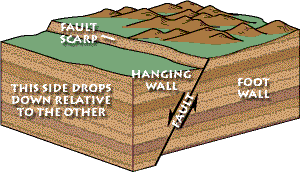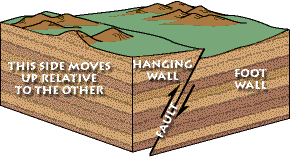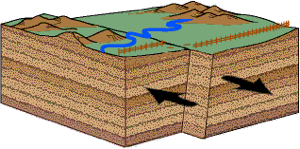Fault types
Types of Faults from: http://geomaps.wr.usgs.gov/
Now, consider this: if we hold the foot wall stationary, gravity will normally want to pull the hanging wall down, right? Faults that move the way you would expect gravity to move them normally are called normal faults!
Compare the image to the right with the normal fault above. Along a reverse fault one rocky block is pushed up relative to rock on the other side.
Can you see the foot-shaped foot wall and the hanging wall resting or hanging above it? Think about this: if we hold the foot wall stationary, where would the hanging wall go if we reversed gravity? The hanging wall will slide upwards, right? When movement along a fault is the reverse of what you would expect with normal gravity we call them reverse faults!
Strike-slip faults have a different type of movement than normal and reverse faults. You probably noticed that the blocks that move on either side of a reverse or normal fault slide up or down along a dipping fault surface.

All the stress and strain produced by moving plates builds up in the Earth's rocky crust until it simply can't take it any more. All at once, CRACK!, the rock breaks and the two rocky blocks move in opposite directions along a more or less planar fracture surface called a fault.
We classify faults by how the two rocky blocks on either side of a fault move relative to each other. The one you see here is a normal fault. A normal fault drops rock on one side of the fault down relative to the other side. Take a look at the side that shows the fault and arrows indicating movement. See the block farthest to the right that looks kind of like a foot? That's the foot wall. Now look at the block on the other side of the fault. See how it's resting or hanging on top of the foot wall block? That's the hanging wall.


The Keweenaw Fault is a thrust fault, the name we give to prominent reverse faults. They are driven by significant tectonic events that affect large areas, like continental collisions.


